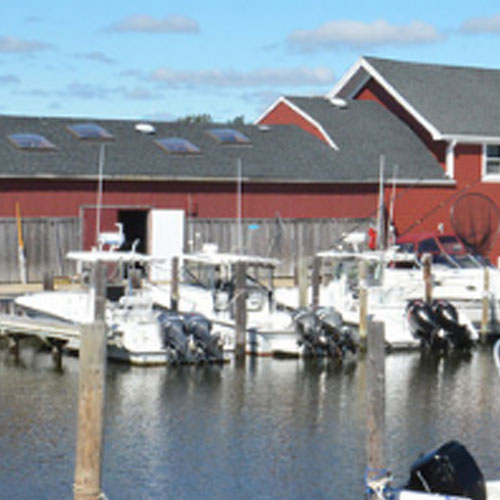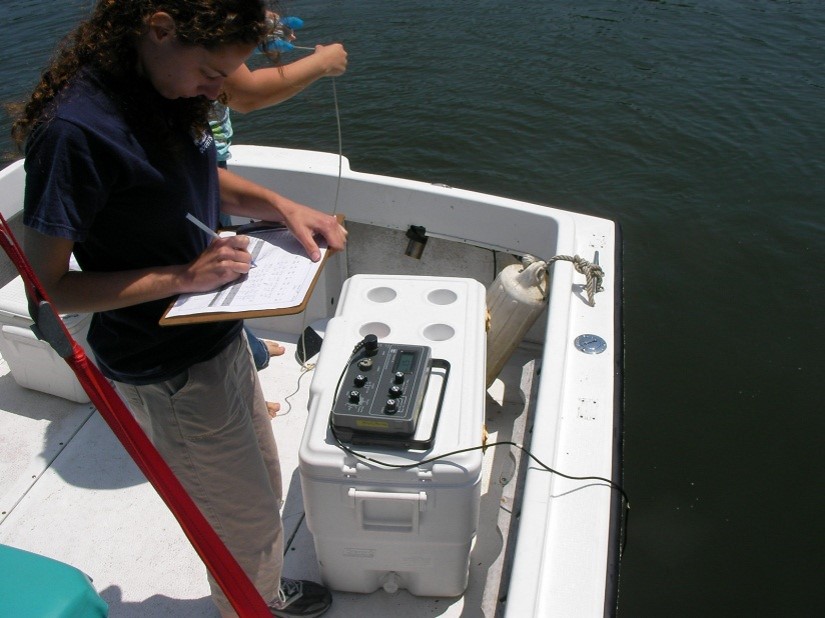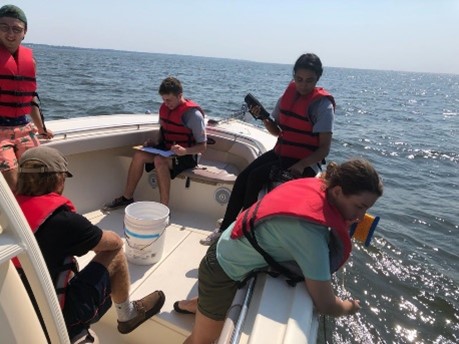CERCOM

Center for Environmental Research and Coastal Oceans Monitoring (CERCOM)
CERCOM is a 3100 sq. ft. field station for coastal environmental monitoring, research and STEM sciences supporting the BS in Earth and Environmental Sciences and the BA is Biology in field studies. Through applied scientific research, hands-on fieldwork in the sciences and a comprehensive environmental monitoring facility of Molloy University is located on the Great South Bay at the historic former Blue Points Oyster Hatchery in West Sayville, New York. CERCOM is committed to advancing knowledge and developing solutions to environmental problems in coastal ecosystems through a network of group-cooperative monitoring activities, Horseshoe Crab captive breeding programs, and collaborative research. In partnership with monitoring networks with federal (NPS, NOAA, USGS, NWS), state (NYSDEC, SSER, NYSDOS), local NGO and international groups (IUCN, The Explorer’s Club, United Nations), CERCOM provides the data necessary to implement ecosystem-based management (EBM). These recommendations assure the long-term health of estuarine environments on Long Island while focusing attention on the ecosystem of healthy estuarine environments worldwide.

CERCOM/ BCES fosters an active internship opportunity for all science students. CERCOM is integral to initiating a career path in the STEM sciences, both physical and biological. Careers in the Environmental Sciences related fields are projected to experience significant growth and will outpace other occupational fields between 2020-2030 according to the U.S. Bureau of Labor & Statistics Occupational Outlook Handbook. Students who earn their B.S. degree in Earth & Environmental Science at Molloy are prepared to meet the rigorous demands necessary to succeed in graduate studies , as well as in careers throughout the environmental sciences. Our Molloy alumni have gone on to secure careers in all sectors of Environmental Sciences like the US Forest Service, Environmental Consulting Firms, and Cold Spring Harbor Labs.
For information on CERCOM, internships and collaborative research, please contact Dr. John T. Tanacredi, Director of CERCOM, and Professor of Earth & Environmental Sciences at Molloy University by email at jtanacredi@molloy.edu.




Student Experiences at CERCOM
Students have many opportunities to engage in academic research, internships or for international travel to gain real world knowledge in the Environmental Sciences.
CERCOM Resources
-
Student Internships
All Earth and Environmental Science majors, must complete at least one semester of an off-campus internship that makes the abstract theories and learned examples concrete by placing you in a real-life work situation performing actual professional tasks. Students have the opportunity to intern at CERCOM or in consultation with Dr. John Tanacredi they may explore the possibility of interning with one of numerous organizations like; the Wildlife Conservation Society, The New York Aquarium, the U.S. Fish and Wildlife Service, The National Park Service, The American Museum of Natural History, The Long Island Maritime Museum, Atlantis Marine World or CRESLI. To find out more information about internships contact us at CERCOM@molloy.edu
-
Internship Highlights

Our students participate in exciting internships either on site at CERCOM or at other Science related institutions. Each summer we offer internships to multiple students to participate in the usual CERCOM animal care and water quality monitoring activities. During a previous summer, CERCOM hosted 8 students, from different majors; Nursing, Darman Kaur; Biology, Thomas Nadraus, Brian Ford, and Ryan Mehryari; Earth & Environmental Studies, Caroline Kane, Desmond Smith, along with Drew O’Connor who also minored in Art & Erin Tudryn who was a double major in Earth and Environmental Studies and Art. These students created a mural in the laboratory extolling the diversity of estuarine species at CERCOM.

The American Museum of Natural History is a long-term collaborator with CERCOM and allows Molloy students the unique opportunity to work on natural resource specimens or artifacts. Keegan Walker, Earth & Environmental Studies major, interned at AMNH and was able to complete the reconstruction of two turtle voucher specimens for reptile displays and for further herpetological research at American Museum of Natural History.
-
Faculty/Student Collaborations

Students work alongside our faculty on a variety of research projects in the Environmental Sciences. Director of CERCOM and Professor of Earth & Environmental Science, Dr. John Tanacredi recently collaborated with Drew O’Conner, Environmental Science and Art alumni on a unique project that utilized her skills in both of her majors. Drew illustrated some of the graphics in Dr. Tanacredi's recently published book entitled “The Redesigned Earth”.
-
International Travel

Students can travel the world with the Office of International Education on trips that provide an education like no other. Our Environmental Science students have traveled to exotic places like the Galapagos Islands, Chile and Easter Island. Earth & Environmental Sciences Alumni, Melissa Fuerst traveled to the Galapagos Islands to experience the unique ecosystems of the islands. She witnessed first hand some of the conservation efforts of the tortoise species with the captive breeding of over 950 individual tortoises at the Charles Darwin Center. The trip to Chile and Easter Island provided Earth & Environmental Science alumni, Joshua Greer with an unparalleled experience of a lifetime.
-
Teachers
The Horseshoe Crab Teacher Toolbox is offered as an on-line library for educators from around the world to share lesson plans, print materials, and audio-visual resources. Materials can be uploaded to or downloaded from the Toolbox and easily viewed as lists by the four categories shown at left.
For access to the toolbox, please contact Regina Gorney at CERCOM@molloy.edu
-
Media
As the experts on Enviromental Science and the Long Island Coastal waterways, CERCOM can provide experts to speak on a variety of topics. Please email cercom@molloy.edu to book a speaker. For press inquiries contact Regina Gorney at 516-323-3594.
-
Visit CERCOM
CERCOM welcomes high school students and those wanting to learn more about the mission and monitoring activities at CERCOM. If you or your class would like to book a trip to CERCOM or request a guest speaker, please contact cercom@molloy.edu
-
The Coastal Monitor Newsletter
Issues of The Coastal Monitor can be found by exploring our site at:
The Coastal Monitor CERCOM | CERCOM | Molloy University
To sign up for our monthly newsletter please email Cercom@molloy.edu
-
Long Island Horseshoe Crab Network Annual Inventory
The Long Island Horseshoe Crab Inventory is a Horseshoe Crab Habitat Monitoring project covering 115 beach locations from Brooklyn – Montauk during optimal breeding season, June through August. This 20-year initiative takes place along the Long Island Shoreline for approximately 15 weeks each year, June - August. Volunteers, both students and local community members, visit each site to record any breeding pairs, horseshoe crab activity such as nesting presence or molts. The sites are visited within two days either before, during, and two days after, the monthly Full and New Moons. The data is then submitted online to CERCOM where an annual Horseshoe Crab Report is prepared and available upon request by emailing CERCOM@molloy.edu
Do you want to help?We need volunteers to visit our Long Island beaches and help take inventory of the horseshoe crab population. If you would like to volunteer, please email cercom@molloy.edu to let us know your interest.
Cercom/2024-lunar-calendar.pdf
-
Great South Bay Water Quality Monitoring
The Center for Environmental Research and Coastal Oceans Monitoring (CERCOM) visits 11 locations in Great South Bay to monitor dissolved oxygen (DO), pH, salinity, clarity, and temperature. This monitoring program has been conducted for the past 20 years. These parameters are critical in determining long-term water quality conditions in Long Island estuaries. Methodologies for monitoring parameters are provided by the Standard Methods for the Examination of Water and Wastewater 20th Edition (1998). Samples are analyzed on a weekly basis from 2 weeks before Memorial Day to one week after Labor Day annually. A GPS (Global Positioning System) receiver is used to provide locations (site coordinates). The coordinates were entered into a GIS (Geographical Information System) database developed at Molloy University /CERCOM. Impairments in water quality are important to assess as ecosystem-based management practices are implemented regarding fishing (commercial) and recreational (social) activities. The Great South Bay is within the Southshore Estuarine Reserve management by the New York State Department of State and the NYSDEC. The Molloy University Water Quality Report is an annual report and is available upon request by emailing CERCOM@molloy.edu
-
Great South Bay Summer Phytoplankton Identification Monitoring
At the CERCOM Field Station the Annual Phytoplankton Inventory is monitored at 5 of the 11 water quality sites for phytoplankton, using a plankton tow net. This monitoring is performed weekly to provide a detailed view of overall bay health. Phytoplankton are the foundational organisms critical to evaluating ecological health of the estuaries of the world. Identifying species diversity, density and distribution of these seminal species supporting healthy trophic structure of these most productive ecological systems on Earth, is a mandatory activity so as to identify potential threats to productive ecosystem functioning. Natural blooms of phytoplankton are necessary to support the diversity of herbivorous species that require a rich assortment of species for proper survival and sustainability as natural contributors to trophic funding. Periodic and infrequent “Hazardous Algal Blooms” (HABs) attributable to changes in water quality and seasonal variability, is a NOAA high priority program Nationwide. CERCOM’s contribution is the monitoring data regarding species diversity and natural species population under normal conditions. Each species is identified, classified, photographed, and counted for submission to the NOAA’s National Phytoplankton Monitoring Network (PMN). Reports are available upon request at cercom@molloy.edu
-
Daily Meteorological Report
Meteorological data is collected daily at CERCOM and is submitted to the National Weather Service (NWS), in Upton NY at the Brookhaven National Laboratories. Air Temperature, wind speed and direction, pH of precipitation, rain gauge, barometer pressure, cloud cover and estimated altitude by type, are data sets compiled and submitted to the NWS daily. CERCOM’s Co-Op site is the only continuous operating facility on Great South Bay. Student Interns are responsible for collection and recording this set of local weather conditions. All data is recorded by NWS and can be retrieved by emailing us at CERCOM@molloy.edu
-
USGS Tide Gauge- Sea-level and pH Daily Monitoring
The USGS maintains the only formal Tide Gauge Station on Great South Bay for the expressed importance of measuring trends in sea level rise and unique water quality parameters of DO and pH. The tide gauge is provided to CERCOM/ Molloy University through a cooperative agreement spanning 10 years, with United States Geological Survey (USGS). Data from the tide gauge is critically important for coastal water level monitoring, which is significant for many coastal activities including navigation, sound engineering, habitat restoration, storm preparedness and ecological preservation.
CERCOM Events
CERCOM Faculty & Staff
-
Dr. John Tanacredi Ph.D.
Professor of Earth & Environmental Science
Department of Biology, Chemistry & Environmental Science
Kellenberg Hall Room 302
516-323-3415
CERCOM Director
132 Clyde Street, Room 8
West Sayville, NY 11797
516-323-3594
-
Regina Gorney
Administrative Coordinator
132 Clyde Street, Room 8
West Sayville, NY 11797
516-323-3594
-
Kyle Maurelli
Scientific Research Technical Assistant
132 Clyde Street, Room 8
West Sayville, NY 11797
516-323-3590
